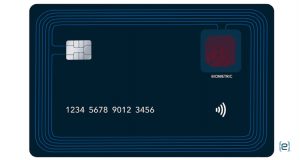Contactless Biometric Credit Cards Combine Next Gen Security with Ease of Use


Worldwide, consumers use over 7 billion credit cards, nearly one card for every infant, child, and adult on the planet. Credit cards have revolutionized how we pay for goods and services. However, they have also proven attractive targets for fraudsters. To retain ease of use while increasing security, the payment industry has recently introduced biometric credit cards.
Consumers Embrace Contactless Payments
Along with accelerating digital transformation, 2020 highlighted the importance of contactless payment options. Restaurants encourage patrons to look at menus and even order through mobile apps. Stores increasingly refuse to accept cash payments. And consumers hesitate to hand over a card or sign with a pen that others have used before them.
Mobile payments entered the scene in 2014 with Apple Pay. But not all merchants accept them, and consumers have proven relatively slow to adopt mobile pay. Contactless, or tap and go, credit cards have added desired convenience, with no PIN or signature required. But, like chip cards, anyone with access to the card can make purchases.
Rather than add a totally new device, banks and technology innovators have joined forces to improve credit card technology. Biometric credit cards deliver the contactless features of the tap and go cards with significant added security.


Biometric Credit Cards Explained
Following hundreds of pilot projects, several companies have announced the deployment of biometric credit cards, certified by both Visa and Mastercard. The cards use embedded fingerprint sensors to verify the identity of the person using the card for in-store purchases.
When customers obtain a new biometric card, they enroll their thumbprint on the card, just as they would on a smartphone. Then, to make a purchase, they hold the card over the EMV terminal like normal, with their thumb on the built-in sensor on the card’s surface. The biometric card checks the scanned print against the print stored in the card.
Authentication at the point of purchase takes a second or two, the same as a PIN, and users can store a second fingerprint as a backup. The cards meet the ISO standard for size and thickness and require no physical contact with the reader.
Benefits of the New Cards
The new biometric credit cards offer several key benefits to consumers, including:
-
- Ease of use – Cardholders pay for goods or services with a simple tap, no need for a PIN or signature or for any physical contact. Authentication happens in a second or two.
- Increased security – Because biometric cards require a fingerprint, they only work for the authorized user. Someone who steals the card cannot use it for an in-store transaction. In addition, the fingerprint data never leaves the card. The merchants and card providers have no access to it.
- Anti-spoofing – Biometric innovator SmartMetric has taken security even further by developing anti-spoofing technology. The new tech includes “liveness detection” designed to spot attempts to use fingerprint replicas to fool the biometrics inside the card.
- Contactless, but without payment caps – Typically, contactless payment methods such as payWave or PayPass include spending limits for individual purchases. For anything above that limit, users must enter a PIN to verify identity. The additional security of biometric credit cards, however, allows for removal of the transaction cap.
- Self-charging – The biometric sensor gains all the power it needs from the payment terminal, so there is no need to re-charge a battery.
Card issuers see the potential benefits for merchants. In the first place, the biometric cards work with existing EMV payment terminals that already accept chip cards. Thus, merchants have no need for expensive hardware upgrades. Further, the increased security should increase consumer confidence and reduce the possibility of credit card fraud.
Retail Technology Partner
eMazzanti works with retailers across the globe to combat digital threats and capitalize on emerging technologies. As an active member of the PCI Security Standards Council, eMazzanti will help you fully implement, integrate and monitor your POS technology. With EMV integration, you can accept biometric credit cards and other contactless payment methods.
Recent Posts
Secure Manufacturing: Protecting Your Business in a Digital Age
Discover how manufacturers can protect their operations, intellectual property, and sensitive data from cyber threats…
Elevate Your Business with eCare SEO & Digital Marketing Services
Discover how eCare SEO & Digital Marketing can help your business thrive online with expert…
Safe and Connected: Strengthening Your Wi-Fi Security with WatchGuard
Discover how WatchGuard Wi-Fi solutions enhance your business security and productivity with cutting-edge technology.
Protecting Every Device: A Guide to Endpoint Security
Discover how endpoint security solutions protect devices from cyber threats, ensuring data safety in the…
Enhance Your Business Network with eCare Network Management
Discover how eCare Network Management can optimize, secure, and monitor your IT infrastructure 24/7, freeing…
Strengthening Your First Line of Defense with MXINSPECT Security Awareness Training
Discover how MXINSPECT Security Awareness Training can fortify your organization against cyber threats.


